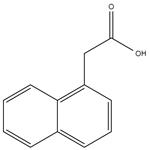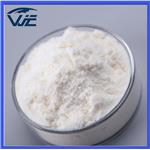- 1-Naphthaleneacetic acid
-

- $5.00 / 1KG
-
2024-04-15
- CAS:86-87-3
- Min. Order: 1KG
- Purity: 99%
- Supply Ability: g-kg-tons, free sample is available
- 1-Naphthaleneacetic acid
-

- $280.00 / 1KG
-
2023-08-16
- CAS:86-87-3
- Min. Order: 1KG
- Purity: >99%
- Supply Ability: 50000kg/Month
|
| | 1-Naphthaleneacetic acid Basic information |
| | 1-Naphthaleneacetic acid Chemical Properties |
| Melting point | 141-143 °C(lit.) | | Boiling point | 280.69°C (rough estimate) | | density | 1.1032 (rough estimate) | | refractive index | 1.6010 (estimate) | | Fp | >100°C | | storage temp. | Sealed in dry,Room Temperature | | solubility | acetone: 50 mg/mL, clear | | pka | 4.30±0.30(Predicted) | | form | crystalline | | color | light yellow | | Odor | Odorless | | PH | 3.0 (0.6g/l, H2O, 25℃) | | Water Solubility | Slightly soluble in water, ethanol, acetone, chloroform and ether. | | Merck | 14,6371 | | BRN | 1308415 | | Stability: | Hygroscopic | | InChIKey | PRPINYUDVPFIRX-UHFFFAOYSA-N | | LogP | 2.240 | | CAS DataBase Reference | 86-87-3(CAS DataBase Reference) | | NIST Chemistry Reference | 1-Naphthaleneacetic acid(86-87-3) | | EPA Substance Registry System | 1-Naphthaleneacetic acid (86-87-3) |
| | 1-Naphthaleneacetic acid Usage And Synthesis |
| Description | 1-naphthaleneacetic acid (NAA), also known as α-naphthaleneacetic acid, belongs to a class of organic compounds of naphthalenes, which contain a naphthalene moiety of two fused benzene rings. NAA is a synthetic auxin plant hormone. It is used as a plant growth regulator to control preharvest fruit drop, flower induction and fruit thinning in various crops such as apples, potatoes, olives, and citrus fruits. It is used as a rooting agent and used for the vegetative propagation of plants from stem and leaf cutting. It is also used for plant tissue culture and as herbicide. Applied as a dust or spray it delays dissolution of the abscission layer, retarding the fruit drop. The effect of NAA on plant growth is greatly dependent on the time of admission and concentration. When used after four weeks, NAA stimulates shoot growth, while full-time use limits growth. When used in a 4-week pulse, adventitious root growth is greatly increased. | | Chemical Properties | White needle crystal or crystalline powder, odorless. Slightly soluble in cold water and ethanol, easily soluble in hot water, acetone, ether, chloroform, benzene, acetic acid and alkali solution. | | Application | 1-Naphthaleneacetic acid (NAA) is a synthetic phytohormone auxin that is added to cell culture media such as Murashige & Skoog media and Chu′s N6 media. | | Uses | 1-Naphthaleneacetic acid is widely employed in agriculture as a synthetic plant hormone in the auxin family or a plant growth regulator, which can find applications in tissue culture. Inducing rooting of plant cuttings, spraying apple trees to prevent early drop, fruit thinner.
1-Naphthaleneacetic acid has been used:
to modify MS media for the initiation of callus
as a supplement in solid K3 medium for the selection of transformants
in the preparation of culture medium like V-KM medium and Cg medium | | Preparation | Industrially, 1-naphthaleneacetic acid is prepared by condensation reaction of naphthalene and chloroacetic acid in the presence of catalyst potassium chloride or aluminum powder. | | Definition | ChEBI: 1-naphthaleneacetic acid is a naphthylacetic acid substituted by a carboxymethyl group at position 1. It has a role as a synthetic auxin. It is a conjugate acid of a 1-naphthaleneacetate. | | General Description | 1-Naphthaleneacetic acid is widely employed in agriculture as a synthetic plant hormone in the auxin family or a plant growth regulator, which can find applications in tissue culture. It is used for the vegetative propagation of plants from stem and leaf cutting, abscission promoter and substrate for auxin inducers of specific plant enzymes. Further, it stimulates root formation in cuttings of woody and herbaceous plants. It is also used to prevent premature flower and fruit drop. It is also employed to control regrowth of tree sprouts after trimminguse. In addition to this, it is used in ornaments and serves as an ingredient in many commercial plant rooting horticultural products. | | Hazard | Skin irritant. | | Agricultural Uses | Plant growth regulator: An agent for thinning fruit sets in apples, pears, olives
and some citrus. Induces root formation on cuttings
and transplants. Inhibits fruit drops. Not currently registered
in EU countries (pending). Registered for use in
the U.S. and Canada. | | Trade name | AGRONAA®; ALCO® NAA; ALPHASPRA
®; AMCOTONE® APPL-SET®; CELMONE®;
DESTRUXOL®; DIP’N GROW®; FRUITONE®;
GOLDENGRO®; HORMEX®; KLINGTITE®; LIQUISTIK
®; NAA 800®; NAFUSAKU®; NIAGARASTIK
®; NU-TONE®; PARMONE®; PHYMONE®;
PIMACOL-SOL®; PLANOFIX®; PLUCKER®;
PRIMACOL®; RHIZOPON B ROOTING POWDER;
ROOTONE® (component, with Indole-3-butyric acid and
1-Naphthaleneacetamide); STAFAST®; STIK®; STOPDROP
®; TEKKAM®; TIPOFF®; TRANSPLANTONE®
(component, with 1-Naphthaleneacetamide); TREHOLD
®; VARDHAK® | | Biochem/physiol Actions | 1-Naphthaleneacetic acid is one of the synthetic auxins, used in plant propagation. It can induce the formation of lateral and adventitious roots. | | Safety Profile | Poison by
intraperitoneal route. Moderately toxic by
ingestion. Mutation data reported. A skin,
mucous membrane, and severe eye irritant.
Can cause depression. A pesticide, When heated to decomposition it emits acrid
smoke and irritating fumes. | | Potential Exposure | 1-Naphthaleneacetic acid is a carboxylic acid plant growth regulator used for thinning fruit sets in apples, pears, olives, and some citrus. Induces root formation on cuttings and transplants. Inhibits fruit drops. Not currently registered in EU countries (may be pending). | | Shipping | UN1759 Corrosive solids, n.o.s., Hazard Class:
8; Labels: 8-Corrosive material, Technical Name Required. | | Purification Methods | Crystallise the acid from EtOH or water. [Beilstein 9 H 666, 9 IV 2424.] | | Incompatibilities | Incompatible with oxidizers (chlorates,
nitrates, peroxides, permanganates, perchlorates, chlorine,
bromine, fluorine, etc.); contact may cause fires or explosions.
Keep away from alkaline materials, strong
bases, strong acids, oxoacids, epoxides, chlorates nitrates, ammonia, aliphatic amines, alkanolamines, isocyanates,
alkylene oxides, epichlorohydrin. Compounds of the carboxyl
group react with all bases, both inorganic and
organic (i.e., amines) releasing substantial heat, water and a
salt that may be harmful. Incompatible with arsenic compounds
(releases hydrogen cyanide gas), diazo compounds,
dithiocarbamates, isocyanates, mercaptans, nitrides, and
sulfides (releasing heat, toxic, and possibly flammable
gases), thiosulfates and dithionites (releasing hydrogen sulfate
and oxides of sulfur). | | Waste Disposal | Incineration. In accordance
with 40CFR165, follow recommendations for the disposal
of pesticides and pesticide containers. | | References | [1] https://en.wikipedia.org/wiki/1-Naphthaleneacetic_acid
[2] http://pmep.cce.cornell.edu/profiles/herb-growthreg/naa-rimsulfuron/naa/herb-prof-naa.html |
| | 1-Naphthaleneacetic acid Preparation Products And Raw materials |
|